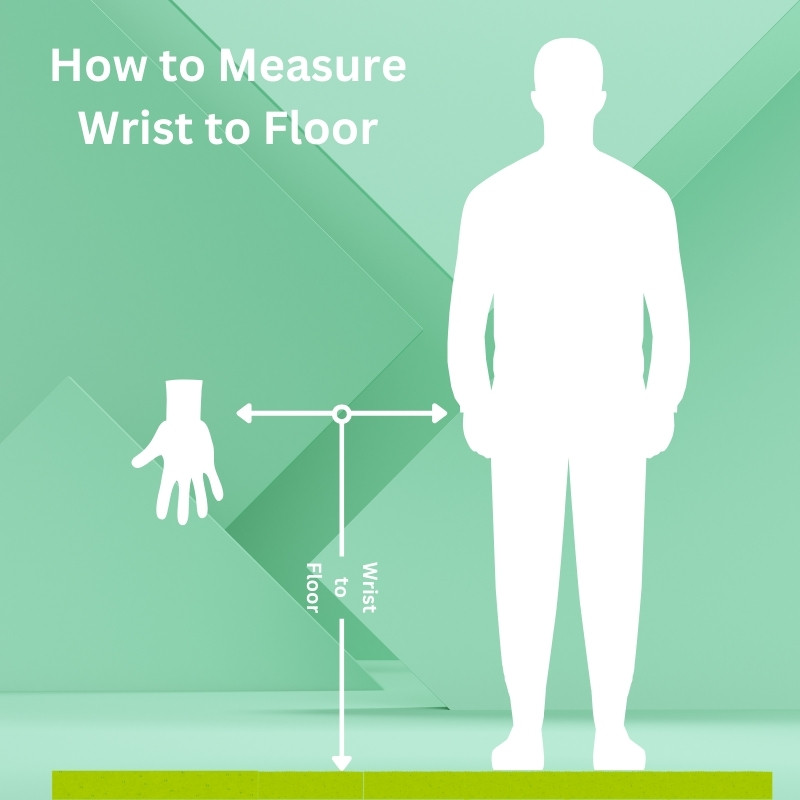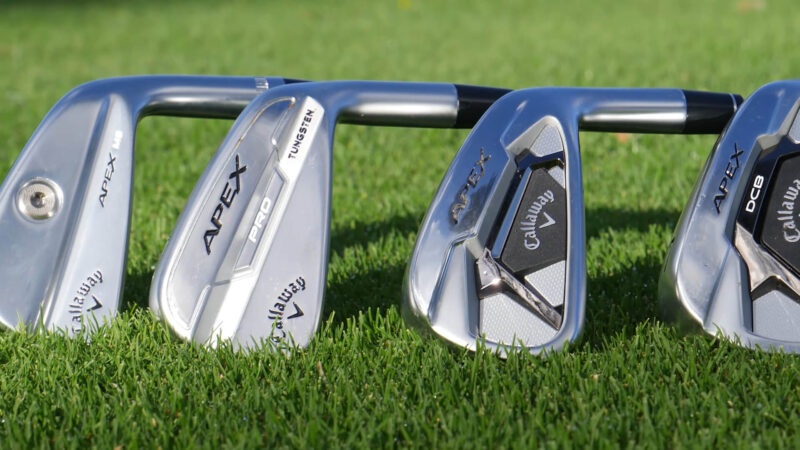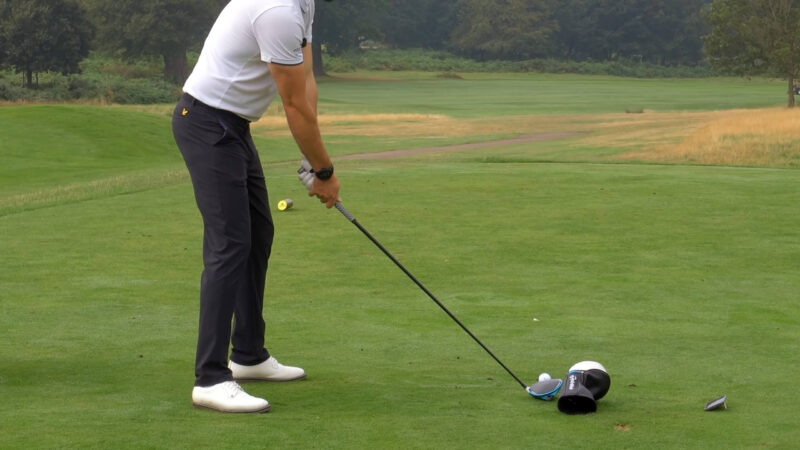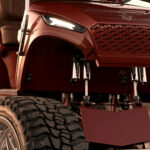Getting the right length for your golf clubs can make a big difference in how well you play. If your clubs are too long or too short, your swing might be off, and it could mess with your accuracy.
Your height and the distance from your wrist to the floor are key measurements to figure out what works best for you. It’s all about making sure the club fits you right, so you get better control and hit more solid shots.
A proper fit means fewer mistakes and more fun on the course.
How to Measure Your Height for Golf Clubs
Finding the right length for your golf clubs starts with measuring your height. This gives a basic idea of how much to adjust your clubs, but it’s just the first step. Golf clubs are not one-size-fits-all, and your height will directly affect how the club fits in your hands and your swing posture. Here’s how to get that measurement right.
Step-by-Step Guide
- Stand straight: Make sure you’re wearing shoes similar to those you’d wear while playing golf.
- Use a tape measure: Have someone measure from the ground to the top of your head while you stand naturally.
- Compare with a chart: Use your height and compare it with a golf club length chart to get a general idea of club length adjustments.
Example Height-to-Club Length Adjustments
- Under 5’0″: Subtract 2 inches from standard club length.
- 5’2″ to 5’4″: Subtract 1 inch.
- 5’7″ to 6’1″: Standard length.
- 6’2″ to 6’4″: Add 1/2 inch.
- Over 6’4″: Add 1 to 2 inches.
Why Height Alone Isn’t Enough
While your height is a great starting point, it’s not the only factor. Golfers of the same height may still need different club lengths because arm and leg length vary. The wrist-to-floor measurement gives a more accurate fit, which we’ll cover in the next section.
Benefits of Proper Club Length
- Improved accuracy
- Better ball striking
- Reduced strain on your back and arms
Why Wrist-to-Floor Measurement Matters?
Wrist to Floor Measurement Table
Wrist to Floor Measurement Table
| Wrist to Floor Measurement | 4′ 10″ | 5′ 0″ | 5′ 2″ | 5′ 4″ | 5′ 6″ | 5′ 7″ | 5′ 8″ | 5′ 10″ | 6′ 0″ | 6′ 2″ | 6′ 4″ | 6′ 6″ | 6′ 7″ | 6′ 9″ |
|---|---|---|---|---|---|---|---|---|---|---|---|---|---|---|
| 40″ | +2.25″ | +2.25″ | +2.25″ | +2″ | +2″ | +1.75″ | +1.75″ | +1.75″ | +1.5″ | +1.5″ | +1.25″ | +1.25″ | +1.25″ | +1.25″ |
| 39.5″ | +2″ | +2″ | +2″ | +1.75″ | +1.75″ | +1.5″ | +1.5″ | +1.5″ | +1.25″ | +1.25″ | +1″ | +1″ | +1″ | +1″ |
| 39″ | +1.75″ | +1.75″ | +1.5″ | +1.5″ | +1.25″ | +1.25″ | +1″ | +1″ | +0.75″ | +0.75″ | +0.5″ | +0.5″ | +0.5″ | +0.5″ |
| 38.5″ | +1.5″ | +1.5″ | +1.25″ | +1.25″ | +1″ | +1″ | +0.75″ | +0.75″ | +0.5″ | +0.5″ | +0.25″ | +0.25″ | +0.25″ | +0.25″ |
| 38″ | +1.25″ | +1.25″ | +1″ | +1″ | +0.75″ | +0.75″ | +0.5″ | +0.5″ | +0.25″ | +0.25″ | Std | Std | Std | Std |
| 37.5″ | +1″ | +1″ | +0.75″ | +0.75″ | +0.5″ | +0.5″ | +0.25″ | +0.25″ | Std | Std | Std | Std | Std | Std |
| 37″ | +0.75″ | +0.75″ | +0.5″ | +0.5″ | +0.25″ | +0.25″ | Std | Std | Std | Std | Std | Std | Std | Std |
| 36.5″ | +0.5″ | +0.5″ | +0.25″ | +0.25″ | Std | Std | Std | Std | Std | Std | Std | Std | Std | Std |
| 36″ | +0.25″ | +0.25″ | Std | Std | Std | Std | Std | Std | Std | Std | Std | Std | Std | Std |
| 35.5″ | Std | Std | -0.25″ | -0.25″ | -0.25″ | -0.25″ | -0.25″ | -0.25″ | -0.25″ | -0.25″ | -0.25″ | -0.25″ | -0.25″ | -0.25″ |
| 35″ | -0.5″ | -0.5″ | -0.5″ | -0.5″ | -0.5″ | -0.5″ | -0.5″ | -0.5″ | -0.5″ | -0.5″ | -0.5″ | -0.5″ | -0.5″ | -0.5″ |
| 34.5″ | -0.75″ | -0.75″ | -0.75″ | -0.75″ | -0.75″ | -0.75″ | -0.75″ | -0.75″ | -0.75″ | -0.75″ | -0.75″ | -0.75″ | -0.75″ | -0.75″ |
| 34″ | -1″ | -1″ | -1″ | -1″ | -1″ | -1″ | -1″ | -1″ | -1″ | |||||
| 34″ | -1″ | -1″ | -1″ | -1″ | -1″ | -1″ | -1″ | -1″ | -1″ | -1″ | -1″ | -1″ | -1″ | -1″ |
| 33.5″ | -1.25″ | -1.25″ | -1.25″ | -1.25″ | -1.25″ | -1.25″ | -1.25″ | -1.25″ | -1.25″ | -1.25″ | -1.25″ | -1.25″ | -1.25″ | -1.25″ |
| 33″ | -1.5″ | -1.5″ | -1.5″ | -1.5″ | -1.5″ | -1.5″ | -1.5″ | -1.5″ | -1.5″ | -1.5″ | -1.5″ | -1.5″ | -1.5″ | -1.5″ |
| 32.5″ | -1.75″ | -1.75″ | -1.75″ | -1.75″ | -1.75″ | -1.75″ | -1.75″ | -1.75″ | -1.75″ | -1.75″ | -1.75″ | -1.75″ | -1.75″ | -1.75″ |
| 32″ | -2″ | -2″ | -2″ | -2″ | -2″ | -2″ | -2″ | -2″ | -2″ | -2″ | -2″ | -2″ | -2″ | -2″ |
| 31.5″ | -2.25″ | -2.25″ | -2.25″ | -2.25″ | -2.25″ | -2.25″ | -2.25″ | -2.25″ | -2.25″ | -2.25″ | -2.25″ | -2.25″ | -2.25″ | -2.25″ |
| 31″ | -2.5″ | -2.5″ | -2.5″ | -2.5″ | -2.5″ | -2.5″ | -2.5″ | -2.5″ | -2.5″ | -2.5″ | -2.5″ | -2.5″ | -2.5″ | -2.5″ |
| 30.5″ | -2.75″ | -2.75″ | -2.75″ | -2.75″ | -2.75″ | -2.75″ | -2.75″ | -2.75″ | -2.75″ | -2.75″ | -2.75″ | -2.75″ | -2.75″ | -2.75″ |
| 30″ | -3″ | -3″ | -3″ | -3″ | -3″ | -3″ | -3″ | -3″ | -3″ | -3″ | -3″ | -3″ | -3″ | -3″ |
| 29.5″ | -3.25″ | -3.25″ | -3.25″ | -3.25″ | -3.25″ | -3.25″ | -3.25″ | -3.25″ | -3.25″ | -3.25″ | -3.25″ | -3.25″ | -3.25″ | -3.25″ |
| 29″ | -3.5″ | -3.5″ | -3.5″ | -3.5″ | -3.5″ | -3.5″ | -3.5″ | -3.5″ | -3.5″ | -3.5″ | -3.5″ | -3.5″ | -3.5″ | -3.5″ |
Wrist to Floor Measurement Table
Measuring your wrist-to-floor (WTF) distance helps customize your golf clubs beyond just your height. Two golfers who stand the same height might still need different club lengths because arm and leg lengths vary. The WTF measurement gives a more accurate reading of your posture and swing dynamics.
How to Measure Your Wrist-to-Floor?

- Stand straight with arms relaxed: Keep your feet shoulder-width apart while standing naturally.
- Measure from the floor to your wrist: Use a tape measure to check the distance from the floor to the crease of your wrist.
- Record the measurement: This is the key number used in customizing your golf clubs.
Example of WTF Adjustments
- WTF under 34 inches: Clubs should generally be shortened.
- WTF between 34 and 37 inches: Standard length clubs will likely work.
- WTF over 40 inches: Consider adding 1 inch or more to your clubs.
Standard Club Lengths
Standard golf club lengths are designed based on averages, but not everyone fits perfectly into these norms. These lengths offer a general guideline for beginners or golfers buying off-the-shelf clubs.
However, individual factors like posture, swing style, and overall build can affect how well standard clubs perform for you.
- Driver: Typically 45 to 46 inches for men, slightly shorter for women.
- Irons: A 5-iron is usually around 38 inches, with shorter irons gradually reducing by about half an inch.
- Putters: Standard putter lengths range from 33 to 35 inches, depending on personal preference.
Why Standard Length Clubs May Not Work for Everyone?
While standard lengths suit many players, they don’t account for individual factors like wrist-to-floor measurements, swing dynamics, or personal comfort. Custom fitting can adjust club lengths to better suit your specific needs, leading to better results on the course.
Key Drawbacks of Standard Lengths
- Inconsistent ball striking due to improper length
- Discomfort over time, leading to swing adjustments or injuries
- Limited personalization for improving swing mechanics
Custom Fitting for Golf Clubs: Is It Worth It?

Custom fitting takes your individual measurements, swing style, and body dynamics into account to fine-tune your golf clubs. Unlike standard clubs, which use average dimensions, custom fitting ensures that every part of your club fits your body and swing perfectly.
How Custom Fitting Works
- Measure height and wrist-to-floor: These measurements help determine the starting length adjustments.
- Analyze swing mechanics: A professional fitter watches your swing to evaluate the best club length, lie angle, and shaft flex.
- Test various club lengths: Trying different lengths helps find what feels and performs best for you.
Benefits of Custom Fitting
- Increased accuracy: Custom-fitted clubs match your swing, leading to more consistent ball striking.
- Improved comfort: With clubs built for your body, you reduce the risk of strain and injury.
- Better distance control: Properly fitted clubs allow you to generate more power, resulting in better distance.
Additional Benefits
- Customized grip size: Custom fitting also adjusts grip thickness for a more comfortable hold.
- Enhanced control: By fine-tuning the club’s length and flex, you’ll find better overall control of your shots.
Driver Length: How It Affects Your Game?

The length of your driver can have a major impact on both distance and accuracy. Drivers come in various lengths, and finding the right one depends on your swing style and personal preferences. While longer drivers might help with distance, they can also make it harder to control your shots.
Standard Driver Length
- Men’s drivers: Typically range from 45 to 46 inches.
- Women’s drivers: Usually measure about 44 inches, slightly shorter than men’s.
Pros and Cons of Driver Length
Longer Driver
- Pros: Can generate more clubhead speed, leading to longer drives.
- Cons: Less control and more off-center hits, which can lead to slices or hooks.
Shorter Driver
- Pros: More control and accuracy, as it’s easier to square the clubface at impact.
- Cons: May sacrifice a bit of distance due to less swing speed.
When to Consider Shortening or Lengthening Your Clubs
Deciding when to adjust the length of your golf clubs depends on how your current set feels and performs. If you’re constantly missing shots or feeling uncomfortable during your swing, your club length might need tweaking.
Both shortening and lengthening your clubs can have significant effects on your game, and the decision should be based on your specific needs.
Signs You May Need to Shorten Your Clubs
- Inconsistent ball striking: If you frequently hit the ball with the heel of the club or struggle to control your shots, your clubs may be too long.
- Posture problems: If you find yourself bending over too much to reach the ball, it could be a sign that your clubs are too long. This can lead to back discomfort over time.
- Fat shots: Consistently hitting the ground before the ball (fat shots) is another indication that your clubs might be too long.
Signs You May Need to Lengthen Your Clubs
- Toe strikes: Hitting the ball with the toe of the club is a common sign that your clubs are too short.
- Thin shots: If you’re hitting the ball too high on the face (thin shots), it could indicate that your clubs are too short for your swing.
- Comfort issues: If you feel like you’re reaching too much or standing too upright during your swing, you might need longer clubs to accommodate your body.
Tips for Trying Out Different Club Lengths
Before making a permanent change to your club length, it’s smart to experiment with different lengths to see what works best for your game. You can either adjust your current clubs temporarily or try out various lengths at a golf shop or during a custom fitting session.
Ways to Experiment with Club Length
- Use temporary extensions: Adding extensions to your club shafts allows you to test different lengths without making permanent changes. These can be removed later if needed.
- Try demo clubs: Many golf shops offer demo clubs of varying lengths that you can test out on the driving range or simulator. This gives you a chance to feel how different lengths affect your swing and ball flight.
- Visit a club fitter: A professional fitter can help you try different lengths based on your swing mechanics, ensuring you get the best fit possible.
What to Pay Attention to When Testing Club Lengths
When trying different club lengths, pay close attention to the following factors:
- Ball Striking: Are you making consistent contact with the center of the clubface, or do you find yourself hitting the toe or heel?
- Comfort: Does the club feel too long or too short, causing discomfort during your swing?
- Accuracy: Do you notice more control over your shots, or are you struggling to keep the ball on target?
Example Feedback from Golfers
- Shortening clubs: Golfers often report that shortening their clubs helps with control and accuracy, particularly with their irons. Many see improvements in their ability to square the clubface, leading to straighter shots.
- Lengthening clubs: Some golfers find that lengthening their clubs leads to more distance off the tee, especially with drivers. However, this can sometimes come at the expense of accuracy if the club becomes too difficult to control.
Practical Tests
- Try on the range: Always test different club lengths on the range or simulator to see how the changes affect your actual ball flight.
- Keep notes: Track the results of each length adjustment, noting any changes in distance, accuracy, or comfort.
FAQs
Can club length affect my swing speed?
Yes, longer clubs can increase your swing speed because they create a larger arc. However, this can sometimes make it harder to control the club, leading to inconsistent shots.
Shorter clubs, on the other hand, may reduce your swing speed but often result in better control and accuracy.
How does my swing style impact the right club length?
Your swing style plays a big role in determining the ideal club length. For example, if you have an upright swing, you might need shorter clubs. If you have a flatter swing, longer clubs may work better.
Getting professionally fitted helps find the right match for your swing style.
Should beginners worry about club length?
Beginners should start with standard-length clubs, as they’re a good baseline. As you improve and understand your swing better, you can explore custom fitting to adjust the length. It’s not something beginners need to worry about right away but can help as you advance.
Does shaft material matter when adjusting club length?
Yes, the material of the shaft can affect how club length adjustments impact performance. Graphite shafts are lighter, making longer clubs easier to swing. Steel shafts are heavier, and when lengthened, they can feel more difficult to control.
The choice of material can affect how comfortable and effective longer or shorter clubs feel.
Can club length affect my putting?
Yes, the length of your putter can significantly affect your putting stroke. A longer putter may help taller players feel more comfortable, while a shorter putter can provide more control for those with a shorter stance or those who prefer standing closer to the ball.
Do I need to adjust all my clubs if I change the length of one?
Not necessarily. You might only need to adjust specific clubs, like your driver or putter, based on your swing and comfort with those clubs. However, if you’re getting custom fitted, it’s a good idea to check the length of all your clubs to ensure consistency across your set.
Last Words
Finding the right length for your golf clubs is key to improving your performance on the course. By considering both your height and wrist-to-floor measurement, you can get clubs that fit your body and swing style.
Whether you’re just starting or have been playing for years, properly fitted clubs help with accuracy, comfort, and control.







